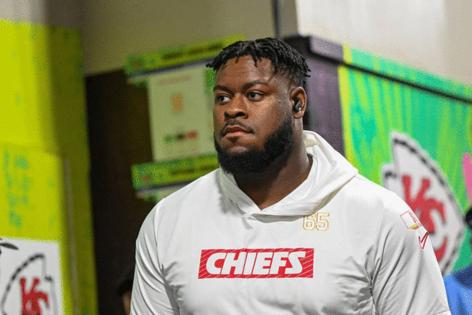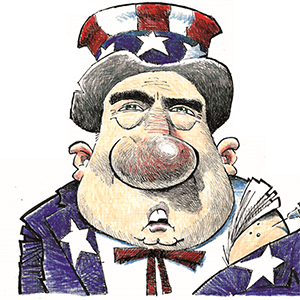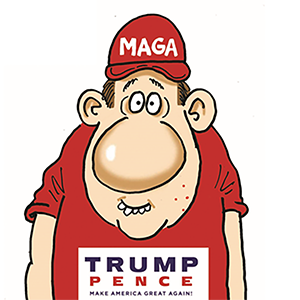Sam McDowell: Why the Chiefs' most important offseason decision is already here -- and what they'll do
Published in Football
KANSAS CITY, Mo. — Nine days after the shock of Super Bowl LIX, before its remnants in Kansas City have even subsided, the proverbial there’s-always-next-year arrived.
Or at least its most pressing decision has arrived:
What should the Chiefs do with right guard Trey Smith?
The NFL franchise tag window unlatched Tuesday, allowing teams to take an initial step toward securing high-profile players — but for a hefty fee.
A prominent group comprises the Chiefs’ list of impending free agents, but none are more prominent than Smith. None will be more expensive, either.
So why not just use the franchise tag to assist his return to Kansas City, the same way the Chiefs used it on cornerback L’Jarius Sneed a year ago, or Orlando Brown Jr. a year earlier, or Chris Jones in 2020?
Well, it’s complicated.
Probably too complicated.
The Chiefs are unlikely to use the non-exclusive franchise tag, which is probably the right decision. That’s not a commentary on Smith.
It’s commentary on a few other circumstances:
The price of a franchise tag
There’s a flaw in the franchise tag system. Well, there are a few flaws. But there’s a specific one that would make it quite difficult to justify placing a franchise tag on Smith over these next two weeks.
All offensive linemen are grouped together.
Why that matters: The price of the non-exclusive franchise tag averages the top-5 salaries of the position from the previous year. Smith is a right guard, a position not paid nearly as handsomely as, say, left tackle. But the franchise tag for his position will factor in those lucrative left tackle deals.
The estimated tag for Smith, therefore, would cost $25.1 million, which is about $5 million (25%) more than the highest-paid right guard in the game, Falcons guard Chris Lindstrom.
That’s hard to justify.
Really, even though Smith is looking for the security of a long-term deal, and he’s certainly earned the security of a long-term deal, a franchise tag ought to be more enticing for the player than the team. How many players have the opportunity to earn $5 million more in one season than the second-highest-paid player at their (real) position? And Smith is only 25 years old, meaning he could reset the market a year later at 26.
Alas, it’s not how any players view it. It’s just that any discussion of the franchise tag possibility is missing a piece of the argument I made a year ago with Chris Jones: The real way players can bet on themselves is to take short-term deals with high guarantees. They can reset the market annually rather than once.
As I said at the top, I don’t see the Chiefs seeking that option, nor the transition tag, because it’s not just about what they’d have to pay Smith — it’s about what they couldn’t pay literally everyone else.
Chiefs’ free agency hurdles
There are quite a few holes on this Chiefs roster.
That’s the price for pushing all-in for the one-time chance at the first three-peat in the Super Bowl era.
The back end leaves the Chiefs needing a left tackle, wide receiver, cornerback, linebacker, running back, a tight end if Travis Kelce were to retire, a safety if they lose Justin Reid and, well, shall I continue?
Putting the tag on Smith might block a key in-house player from hitting the open market, but it would also block the Chiefs from investing money in a player from the outside.
And they need a few.
When you sign a player to a long-term deal, you can back-load the contract in anticipation of the escalating salary cap in future years. With a franchise tag, you have to put those dollars in the immediate budget. It handcuffs your offseason, especially if you’re a team already pushing up against the cap figures.
That math just gets really hard to configure.
Is this the best use of Kansas City’s money?
The Chiefs would love to have Smith on their roster next year. He’s a terrific player on the field and a terrific teammate beloved in the locker room. He might be the best late-day value general manager Brett Veach has ever secured from the draft.
Smith, the player potentially set to become the highest-paid guard in football, was taken at No. 226 overall. There were some other factors at play there with his health. But still, it’s remarkable value.
The Chiefs, though, should seriously ask themselves whether he fits the position they ought to value most.
Creed Humphrey is on the most lucrative contract for a center in football. Joe Thuney, at left guard, is set to occupy 10% of the salary cap.
Do you really need a third expensive interior lineman? It’s a non-premium position.
The question isn’t about whether Smith is worth $20-plus million. He is. It’s about whether he’s worth it to this team given its current roster construction.
And given its quarterback.
Patrick Mahomes’ best seasons have come when his tackles are consistent producers. We already saw what this offense looks like with the best interior line in the NFL. I covered that last week. The analysis is pretty clear.
Smith should get paid. There are teams out there in need of a lot more help between the tackles than the Chiefs.
And teams with a lot more salary cap space than the Chiefs have.
Their offseason pivots on the decision with Trey Smith.
But that might be understated. Really, the existence of a true offseason pivots on that decision.
©2025 The Kansas City Star. Visit kansascity.com. Distributed by Tribune Content Agency, LLC.







Comments